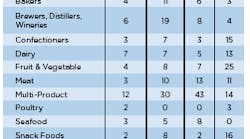But there was one blockbuster, a potential game-changer. Kraft Foods reached across the Atlantic to buy one of England's crown jewels: Cadbury PLC. "The London-based confectioner earned the attention of Kraft for many reasons, but likely would not have been considered if Wm. Wrigley Jr. Co. had not been acquired by Mars Inc. in 2008 for $23 billion," the Food Institute wrote. "That deal restructured the confectioner industry, placing Mars at the top as the largest confectioner in the world. However, 2009's approximately $19.6 billion acquisition of Cadbury by Kraft supplanted Mars."
The Kraft-Cadbury deal also is significant because it represents a big trend in M&A: the importance of the emerging market. Cadbury PLC's "strong grip on India and other emerging markets is the biggest factor in Kraft Foods' aggressive takeover offer for the UK-based candy maker," reported The Economic Times. India is believed to be one of its most resilient markets, with sales growing at 20 percent and profits at 30 percent, even in a competitive market.
Overall, food & beverage deals in 2009 dropped 30.4 percent. "An astounding total, the sharp decline in mergers & acquisitions represents not only the screeching halt that many firms came to in their dealing, but also the shifting markets and categories that many pursued," the Food Institute wrote.
"According to Thomson Reuters merger data, there were 6,772 deals in all industries worth a total of $614 billion through the first eleven months of 2009, compared with 8,890 transactions worth a total of $1 trillion during the same period last year."
The scant 263 mergers in 2009 represents a considerable decline from nearly every year, even lower than 2005, which previously was the nadir for M&A activity within the past decade.
Banks made credit difficult to come by and, for better or worse, private equity and investment firms sat out the year, making most transactions strategically motivated rather than financially motivated. For example, Sun Capital Partners, which was involved in four acquisitions in 2008, did not make any in 2009, according to the report. In fact, an affiliate of Sun sold Timothy's Coffees of the World to Green Mountain Coffee Roasters one year after acquiring the company.
"Many of the targets involved in these transactions were either distressed or had highly strategic motivators," says Brian Basil, director of Grant Thornton Corporate Finance, part of the accounting and business advisory firm. "Average valuation levels fell from 7.8 times EBITDA [earnings before interest, taxes, depreciation and amortization] in 2008 to 6.6x in 2009. So while the food & beverage industry has been rather resilient in the face of subpar economic performance, these metrics demonstrate that even this industry is not immune to severe economic conditions."
Most deals were among businesses within the same subcategory, while also avoiding any redundancies in assets or markets. In the Bakers category, Flowers Foods continues to expand its reach, acquiring assets and raw materials to extend its own business or brands under which to market its goods.
Campbell Soup purchased Ecce Panis and folded it into its Pepperidge Farm operations. General Mills, meanwhile, works to divest itself of assets, with bakeries waiting to pick up the castoffs.
Brewers, Distilleries and Wineries were involved in exactly the same type of acquisitions, but there were no blockbusters – nothing like the 2008 merger of Anheuser-Busch to InBev or the merged U.S.-only sales organizations of SABMiller and MolsonCoors (each of those firms the result of recent mergers).
Among dairy processors, acquisitions represented a consolidation of assets by large companies and were not performed without protest by small dairy firms and investigation by regulatory bodies. Dean Foods purchased Santee Dairies from Stater Bros. Markets, which will continue to buy Santee products from Dean Foods. This deal represents a long-running consolidation trend in dairy.
On an international scale, U.S.-based companies also led in acquisitions with emerging or high-growth market companies in the second half of 2009 with 71 deals, followed by UK-based companies with 25. Considering targets for acquisitions, U.S. and Australian companies were the most popular for emerging and high-growth market companies with 16 acquisitions made in each country, according to a study by KPMG.
The largest domestic deal made in 2009 was not really about food or beverages: PepsiCo's acquisition of its two largest bottlers, Pepsi Bottling Group and PepsiAmericas for approximately $7.8 billion (the deal closed early this year). This reversal of Big Cola's strategy of delegating bottling activities to external companies caused Coca-Cola to do the same this year.


